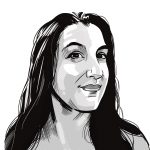
Medicine is one of history’s oldest patriarchies, says Tracy King, and its continuing inequalities explain why women turn to unproven alternatives.
‘You know what they call alternative medicine that’s been proven to work? Medicine.’
The words of Tim Minchin from his rationalist beat poem Storm have become a meme, a line thrown around online in response to unproven claims by complementary and alternative medicine (CAM) practitioners. A kind of rhythmic ‘gotcha’. The punchline isn’t necessarily intended to change anyone’s mind. It’s just a statement of fact.
In the poem, Minchin debates with a woman called Storm, a strawperson who represents and espouses all the hippy beliefs and clichés one might find in an afternoon at Stonehenge. Or the bottom half of YouTube. Storm rejects modern medicine as a grand conspiracy. The spawn of the nebulously evil ‘Big Pharma’. She prefers to put her trust into the alternative, herbal, and spiritual.
I produced an animated video and graphic novel of the Storm poem because, after years researching the serious harms done by alternative medicine, anti-vaccine campaigns, and even psychics, I knew how important Minchin’s message was. Modern medicine has a process of testing and evidence that Storm – and her beloved CAM – reject.
And the CAM industry has to reject contemporary standards for evidence, because when scientific rigour is applied to, for example, homeopathy, it fails. Homeopathy has been proven to not work. Indeed, it cannot work, as anyone with an understanding of basic chemistry should know: no, water doesn’t have a ‘memory’. And yet homeopaths still find clients, and high street pharmacists still sell homeopathic and other alternative remedies.
It’s no coincidence that Storm is a woman. Women make up the majority of users of CAM, and indeed every sort of medicine. We go to the doctor more, and are more aware of medical symptoms in general. Despite the stereotype, this is not women being over-anxious or hypochondriac, it’s men being under-aware of their own health issues, leading to later diagnoses and an earlier average mortality rate. That doesn’t mean, though, that women are going to the doctor and finding solutions. Distrust or rejection of modern medicine is only one reason a woman might turn to CAM. Another, more worrying reason, is that women are being failed by modern medicine. To understand the continuing popularity of alternative medicine, first we have to understand medicine and medical culture. And this is where the sexism comes in.
A womb and a vagina and female-specific biology belong to the half of society which has historically been treated as inferior. Women’s bodies have been ignored, under-researched and misunderstood by doctors and researchers from the very beginning of medicine.
In her groundbreaking 1991 essay The Egg and the Sperm, anthropologist Emily Martin exposed some of the sexism implicit in the way biology has always been understood and taught, with the female reproductive system presented as passive and wasteful, while the male sperm is active, aggressive, powerful. ‘The more common picture – egg as damsel in distress, shielded only by her sacred garments; sperm as heroic warrior to the rescue – cannot be proved to be dictated by the biology of these events’. In fact the egg and sperm have equally active roles, but a quick Google shows that the language on contemporary educational websites remains frustratingly in favour of the outdated sperm-as-warrior tropes.
In her 2017 book Inferior, science journalist Angela Saini gives us the history of this gendered bias in medicine. She describes post-Darwin biologists as ‘obsessed by sex differences, and by how they might pick them out, measure and catalogue them, enforcing the dogma that men are somehow better than women’. This is no surprise: science and medicine have historically been dominated by men.
Medicine is one of the oldest patriarchies in history, literally. At the beginning of what we now consider the era of medicine, the 4th century BC, anyone who wanted to practice medicine had to be a member of a men-only guild. Membership was passed from father to son or son-in-law.
Today, women aren’t legally excluded from medicine – only practically. Although women are now qualifying as GPs in equal numbers or more (as of 2015, the UK had 20,400 female GPs and 19,800 male), they are more likely go part-time: unlike their male counterparts, female GPs are still shouldering the unpaid domestic care burden. No surprise, then, that surgery, the specialism with the most unforgiving schedule, remains 90% male.
Among the examples in Saini’s Inferior is a 2015 British study showing that ‘it took longer for women to be diagnosed after going to the doctor in six of the cancers that affect both men and women. For gastric cancer, women wait on average a full two weeks longer for diagnosis’.
And that’s before we even get to sex-specific illnesses. Saini again: ‘If a [medical] phenomenon affects only women, it’s all too often misunderstood.’ Endometriosis, an incredibly painful and debilitating condition which can lead to infertility, takes an average of seven years to diagnose, and is often brushed aside by doctors as period pain. And yet, Saini quotes John Guillebaud, professor of reproductive health at University College London, as saying that ‘period pain can be ‘almost as bad as having a heart attack’, and [he] admitted it hasn’t been given the attention it deserves, partly because men don’t suffer from it’.
Trust in medicine for women is also deeply affected by media coverage of controversies, including Birmingham surgeon Ian Paterson – who was convicted of 17 counts of malicious and unlawful wounding after undertaking completely unnecessary breast operations on women who did not have cancer (I was one of them) – the vaginal mesh lawsuits, and most recently the ‘technical failure’ which resulted in vulnerable women not being called for routine breast screenings.
So, when the female body has been neglected, under-researched and devalued for so long, is it any wonder that women turn to alternatives?
The average NHS GP appointment is nine minutes, among the shortest in Europe (it should be at least 15 minutes, even the British Medical Association acknowledges that any less is insufficient for a proper diagnosis), compounded by increasingly-long waiting lists and difficulty in getting an appointment in the first place. It can feel like a production line, impersonal and insufficient. Compare that to the homeopath, who will devote between an hour and 90 minutes to a consultation, offering the ultimate in tea and sympathy.
The homeopathy website homeopathyforhealth.org.uk states: ‘One of the things, which often surprises people on their first visit to a homeopath, is the amount of detail they require. This applies not only to your main complaint, but also to your lifestyle, bodily functions, food likes and dislikes, fears and phobias. You may also be asked about your preferences with regard to the weather and your location (e.g. in fresh mountain air or by the sea).’
To the rationalist, this is quite silly. Most of this information will be completely irrelevant to the client’s health, but the homeopath projects an holistic or ‘whole life’ approach that seems to fill the huge void between the nine minutes an overworked, under-funded GP can offer, and a full session of psychotherapy. Follow-up sessions, often over many months, are at least half an hour, and the client sees the same practitioner each time. For those not aware that homeopathy is magical nonsense, it is a huge relief to finally be listened to, to have one’s health in the hands of someone who seems to care.
Homeopaths are strictly regulated in terms of medical claims, but anecdote and word of mouth is a major factor in its enduring popularity. This is in part because of low public understanding of the placebo effect (where an intervention like homeopathy seems to have an effect because the ‘patient’ expects it to) and self-limiting conditions like colds or backache, illnesses or symptoms which improve over time by themselves. Those taking homeopathy often credit it with success that would have happened anyway, or will take an alternative remedy at the same time as, say, a couple of aspirin, then declare the alt med the reason their headache went away.
In Britain, mainly because of the NHS, medicine jogs along nicely without the average citizen having to give much thought to whether or not it works. If it doesn’t work, then your GP isn’t likely to prescribe it, right? Well, that rather depends on your definition of ‘works’. The NHS can – and does – prescribe unproven alternative medicines and treatment to patients, at huge cost to the taxpayer, because of the strength of placebo effect or patient beliefs.
The Good Thinking Society – a charity which campaigns to end the public funding of alternative medicine – estimated that in 2013 the NHS spent between three and five million pounds on homeopathy alone. Thanks in large part to campaigning by the charity, this figure is now significantly lower, with all but two NHS trusts in England and Wales committing to a rejection of the unproven treatment. The saving in London alone is millions. Simon Stevens, the chief executive of NHS England, described homeopathy as ‘at best a placebo and a misuse of scarce NHS funds’.
I spoke to Michael Marshall, project director of The Good Thinking Society, about why he thinks women are still the main consumers of unproven treatments. He told me about a woman he met who suffers from a chronic health condition and who felt she was treated ‘like a guinea pig’ by the NHS, sent from pillar to post without any consistency or care. When she visited a female homeopath, she was treated like a human, not just a set of symptoms.
‘With alternative medicine, the conversation and ownership are different,’ Marshall said. ‘CAM is often marketed and targeted specifically to women, possibly because in women’s media, health issues are seen as lifestyle rather than science.’ This is true. In the lifestyle section of tabloids, or across women’s magazines, anecdotes about miracle cures which focus on the person, not the science, abound. Marshall points out that some of the products sold by Gwyneth Paltrow on her lifestyle website Goop are the same as those sold by conspiracy theorist Alex Jones. The difference is in the marketing. The beauty industry is obsessed with unproven claims about toxins and lymphatic drainage, medical-sounding terms which have no basis in science but appeal to women who are looking for any sort of ownership over their bodies in a culture which barely acknowledges them.
The NHS ending its funding for homeopathy is welcome progress – limited funds shouldn’t be wasted on placebos. But if the gap they leave for women isn’t filled by better research and attention to female biology, it’s women who suffer. And that isn’t progress at all.
Tracy King is a writer, debunker, and science animation producer










